Table of Contents
Check Coolant Level Mercedes Warning: What It Means & How to Fix It
If you’ve ever seen the warning “Check Coolant Level – See Operator’s Manual” appear on your Mercedes dashboard, you know how worrying it can feel. While sometimes the warning is a temporary glitch, in many cases it indicates that your coolant level is low or the coolant sensor is malfunctioning.
Because engine coolant regulates heat and protects against overheating, this alert should never be ignored. Driving with insufficient coolant risks head gasket failure, warped cylinder heads, or even total engine damage — all of which are extremely costly repairs.
In this guide, we’ll explain:
- – What the Check Coolant Level warning means in Mercedes vehicles.
- – The most common causes behind the alert.
- – A step-by-step diagnostic and repair flow.
- – A detailed case study on the Mercedes C300 with the M274 engine.
- – How to safely check and top up your coolant at home.
- – When to trust DIY and when to leave it to professionals.
Why Does the Check Coolant Level Warning Appear?
The Mercedes coolant warning light indicates that your engine’s cooling system may not be functioning properly. The system is critical for:
- – Maintaining safe engine operating temperatures.
- – Preventing overheating and internal wear.
- – Ensuring fuel efficiency and performance.
When this warning appears, it usually means:
- – There is an air-lock or circulation issue in the cooling system.
- – The coolant reservoir is low.
- – The sensor inside the reservoir is stuck or faulty.
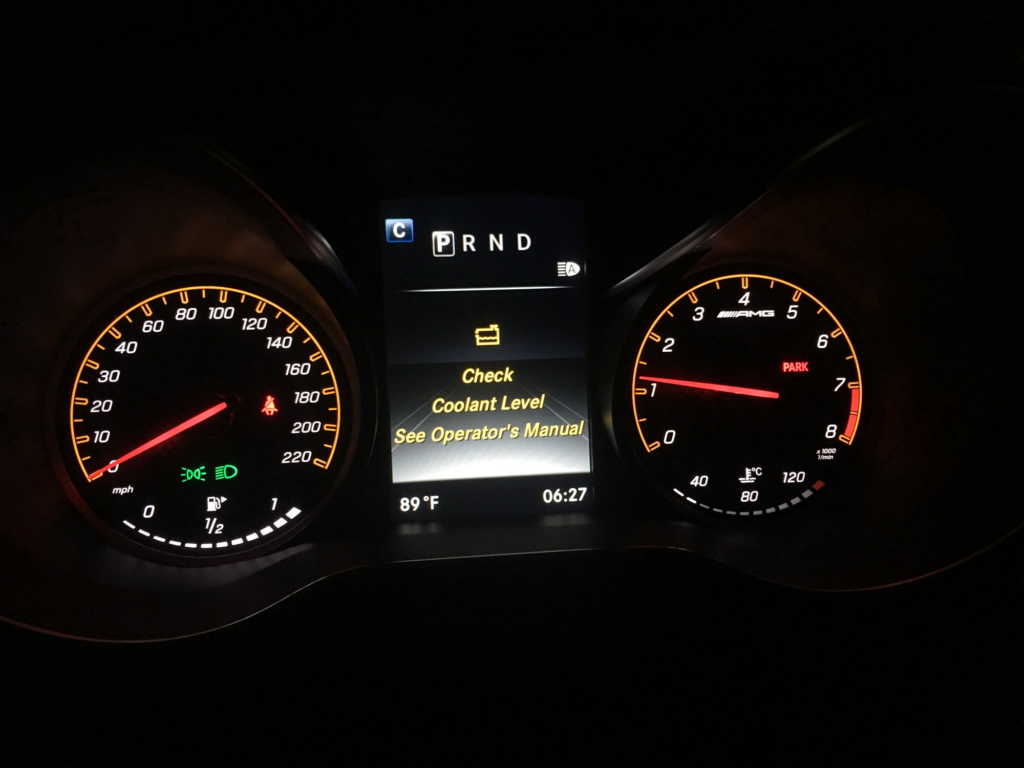
Common Causes & Quick Diagnosis
The following table summarizes the main causes of this warning and the recommended first checks:
| Cause | Symptom & Notes | Recommended Fix |
|---|---|---|
| Low coolant level | Warning appears; topping up clears it. | Add Mercedes-approved coolant to the MAX line. |
| Faulty/sticky level sensor | Coolant level is fine, but warning persists. | Clean or replace sensor in reservoir. |
| Cold start / trapped air | Brief warning that disappears after warming. | Let engine warm, or bleed cooling system. |
| Faulty radiator fan | Fan doesn’t engage; coolant sensor triggers warning. | Test radiator fan; scan with diagnostic tool. |
| Auxiliary circuit issue | Persistent warnings, often in hybrids/EVs. | Dealer may replace reservoir, cap, or update software. |
Step-by-Step Diagnostic & Repair Flow
When the Check Coolant Level message shows up:
1. Start with safety
- – Allow engine to cool before touching the coolant reservoir. Opening it hot can release boiling fluid under pressure.
2. Visual inspection
- – Check the expansion tank’s fluid level. It should be between the MIN and MAX marks.
3. Top-up coolant
- – If low, refill with Mercedes-approved coolant (not just water).
4. Observe the warning
- – Run the engine and see if the warning disappears after warming up.
5. Test radiator fan
- – Turn AC to maximum; the fan should engage. If it doesn’t, suspect a sensor or fan fault.
6. Check the reservoir sensor
- – If the coolant level is correct but the warning persists, clean or replace the level sensor.
7. Run a pressure test
- – A professional test will reveal hidden leaks, especially in the tank, hoses, or cap.
Case Study: Mercedes C300 (M274 Engine)
A Mercedes C300 equipped with the M274 engine exhibited the Check Coolant Level warning on the instrument cluster and experienced overheating. The vehicle owner brought the car to a Mercedes dealership for diagnosis and repair.

Initial Diagnosis
- – Cluster alert: “Check Coolant Level – See Operator’s Manual.”
- – Symptoms: Engine overheating after short drives.
- – Quick checks: Coolant level found low in expansion tank.
Technician’s Intervention
1. Fault Code Scan
- – Diagnostic tool retrieved a fault code linked to the coolant level system.
2. Visual Check
- – Reservoir coolant was indeed low.
3. Pressure Test
- – The cooling system held pressure; no obvious leaks.
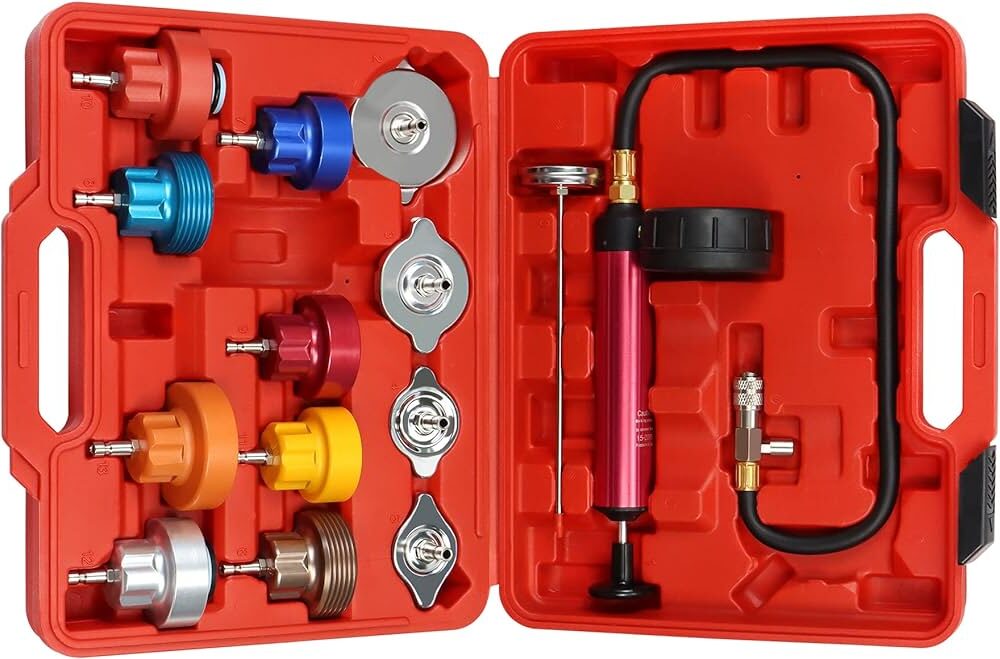
Advanced Diagnostics
- – Thermostat: A sticking thermostat could restrict coolant flow.
- – Electric Water Pump: If failing, circulation is reduced, causing overheating.
- – Expansion Tank & Cap: A cracked expansion tank can release coolant under pressure.
Recommended Repairs
1. Replace thermostat.



2. Replace electric water pump.
- – The electric water pump is crucial for maintaining coolant flow. A malfunction could lead to inadequate coolant circulation and subsequent overheating.


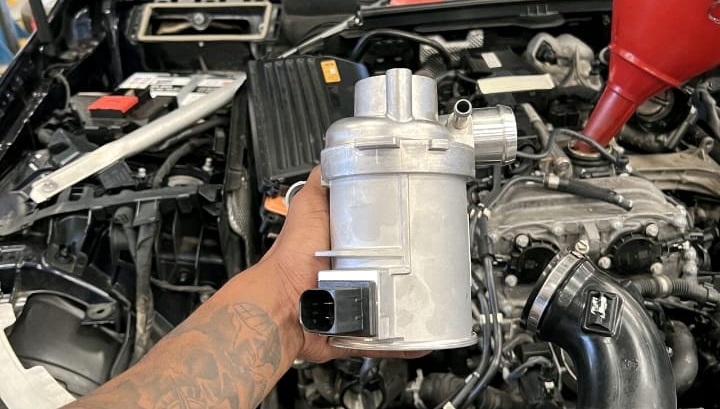
3. Replace expansion tank and cap.
- – The coolant tank and cap maintain the system’s pressure and ensure proper coolant storage and flow. Any fault in these components could cause issues with coolant levels and pressure.

Final Resolution
After replacing these parts:
- – Coolant level stabilized.
- – Overheating stopped.
- – Warning message disappeared.
This case highlights how a comprehensive diagnosis – beyond basic fluid checks – is essential for Mercedes cooling systems.

DIY vs Professional Fixes
Not every cooling system job requires a dealership visit. Use the following guide:
| Task | DIY-Friendly? | Dealer Recommended? |
|---|---|---|
| Check & top-up coolant | Yes | |
| Observe fan operation | Yes | |
| Clean/replace reservoir sensor | Moderate (basic tools) | Yes if unsure |
| Bleed air-locks from cooling lines | Moderate DIY experience | Safer at dealer |
| Replace reservoir/cap (recall) | Dealership recall solution | |
| Replace thermostat or water pump | Complex, requires expertise |
How to check coolant level?

to check the coolant level in car specifically Mercedes, follow the next steps;
Step 1 : Control
- – Check the coolant level in the shadow line area of the expansion tank (2).
- – For coolant expansion tanks (2) with a transparent lower section: If the coolant level is above the shadow line.
- – Coolant level correct, check complete, no further work sequence is necessary. If the coolant level is below the shadow line.
- – Check the coolant level in the coolant expansion tank (2), then proceed with work sequence 2.
Step 2 : Remove
- – Unscrew the cap (1) of the coolant expansion tank (2).
Steps 3 : Control
- – Check the coolant level.
- – When the engine is cold, the coolant level should reach the mark (arrow) in the coolant expansion tank (2). In the case of hot coolant: approximately 1 cm (0.39 inches) above the mark (arrow).
- – If the coolant level is too low, On separate order, check the tightness of the cooling system and the antifreeze concentration of the coolant.
Steps 4 : install
- – Close the coolant expansion tank (2) with the cap (1).
How to add coolant to car ?

To add coolant to car, follow the following steps;
- 1. Check the coolant level in the coolant expansion tank (2).
- 2. Drain the coolant, the steps here => Service B on Mercedes C300 : Steps DIY in the chapter “How to replace engine coolant ?“
- 3. Fill with new coolant.
Preventive Tips
- – Inspect regularly: Check coolant every 1–2 months.
- – Use OEM coolant: Always stick to Mercedes-approved fluids.
- – Don’t ignore small leaks: Even a cracked cap can slowly drain coolant.
- – Pay attention to early warnings: A brief alert during cold starts may indicate an air bubble or sensor issue.
- – Schedule regular servicing: Coolant flushes and inspections should be part of every major service.
Key Learnings from the Case Study
- – Thorough Diagnostics: Even when no leaks are visible, hidden faults like thermostat or pump failures may exist.
- – Expertise Matters: Advanced systems require technicians who know Mercedes-specific quirks.
- – Preventative Replacement: Replacing multiple cooling components together reduces risk of repeat failures.
Conclusion
The “Check Coolant Level – See Operator’s Manual” warning in a Mercedes should never be ignored. While sometimes the issue is as simple as topping up coolant, other times it points to deeper problems like a failing water pump, thermostat, or cracked expansion tank.
The case study of the Mercedes C300 M274 engine showed how a step-by-step diagnostic approach, including advanced checks, successfully resolved the issue and prevented further damage.
More Mercedes Cooling System Resources
Want to explore more causes, symptoms, and repair tips for coolant leaks, overheating, and contamination?
Learn more about Mercedes cooling system faults in our full Cooling System Guide.
FAQ – Check Coolant Level Mercedes
1. What does “Check Coolant Level” mean in a Mercedes?
This message indicates that the coolant level is low in the expansion tank, or the coolant level sensor is malfunctioning. In some cases, the alert may appear briefly during a cold start and disappear after the system stabilizes.
2. Can I drive with a Check Coolant Level warning?
You should avoid driving long distances with this warning. If coolant is low, it may cause engine overheating and lead to costly damage. Safely top up with Mercedes-approved coolant, and if the message persists, seek professional inspection.
3. How do I check coolant level in a Mercedes?
Allow the engine to cool, then check the expansion tank. The level should be at the shadow line mark when cold. If it’s below, carefully unscrew the reservoir cap and top up with the correct coolant mix.
4. Why does the warning persist even after topping up?
If the warning continues, it may be due to a faulty sensor, thermostat, water pump, or cracked expansion tank. A professional pressure test or diagnostic scan is required to pinpoint the fault.
5. How much does it cost to fix coolant level issues in a Mercedes?
- – Coolant top-up: $50–$100 (including correct fluid).
- – Expansion tank replacement: $200–$400.
- – Water pump replacement: $700–$1,200.
- – Thermostat replacement: $400–$600.
Author
Written by: Mercedes Expert
Automotive Technical Trainer & Mercedes-Benz Diagnostic Specialist
With years of hands-on experience repairing and diagnosing Mercedes-Benz vehicles, specializes in case-study-based troubleshooting guides that blend workshop accuracy with educational clarity.
Last Updated: August 2025
— Salim, Mercedes Expert
Independent specialist in Mercedes-Benz diagnostics, CAN Bus analysis, troubleshooting case studies, and EV systems.

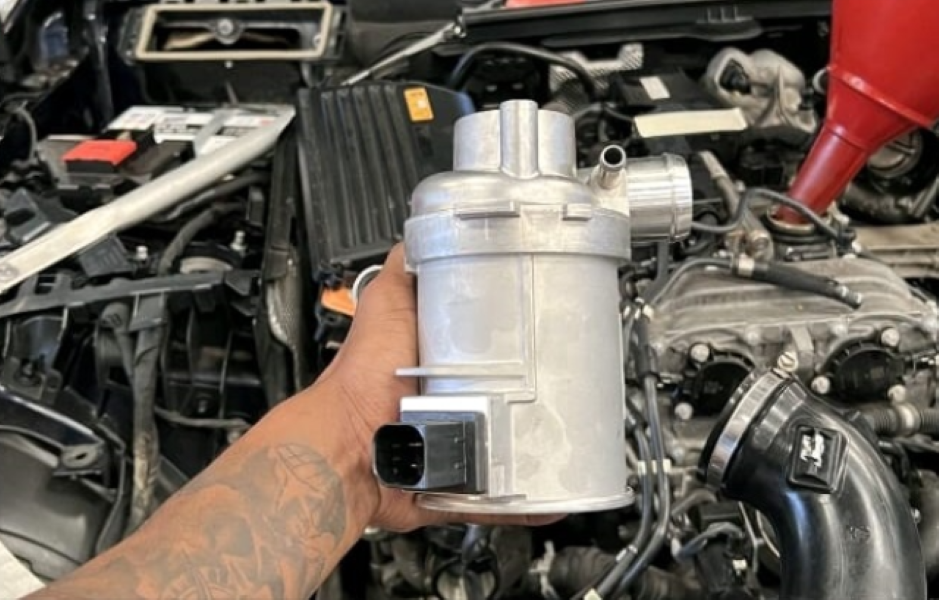

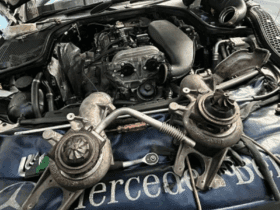



Leave a Reply